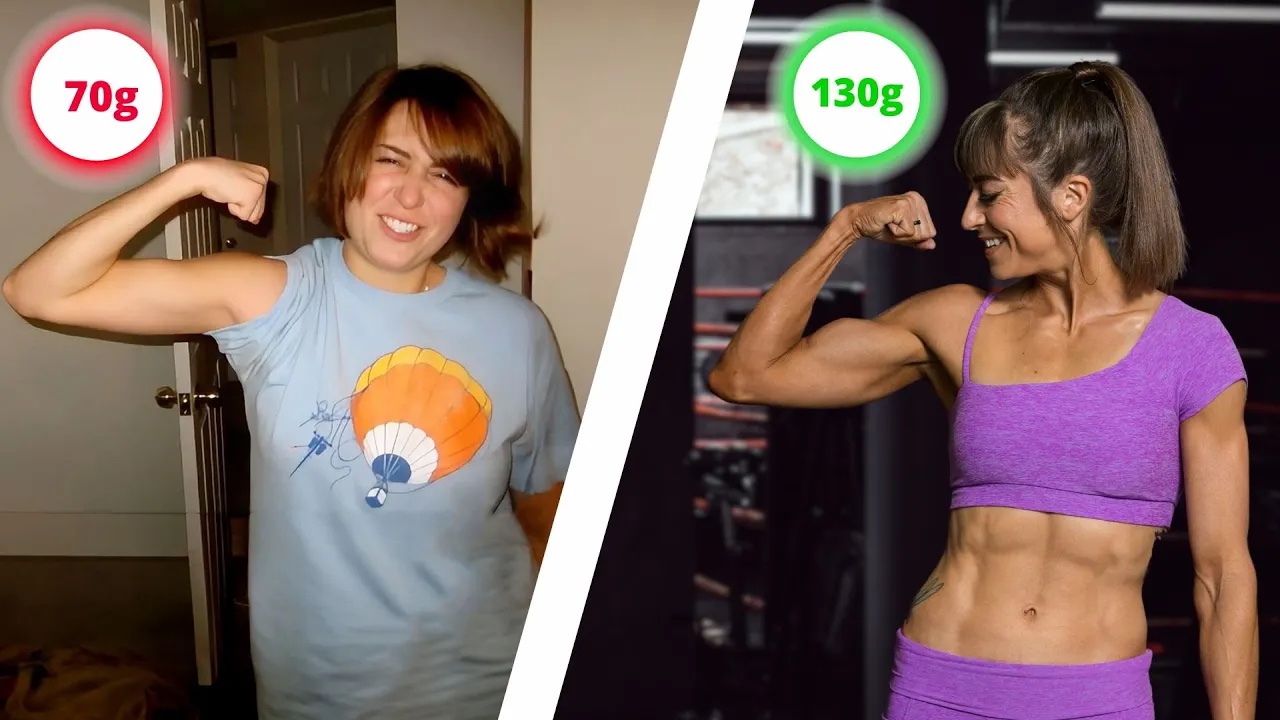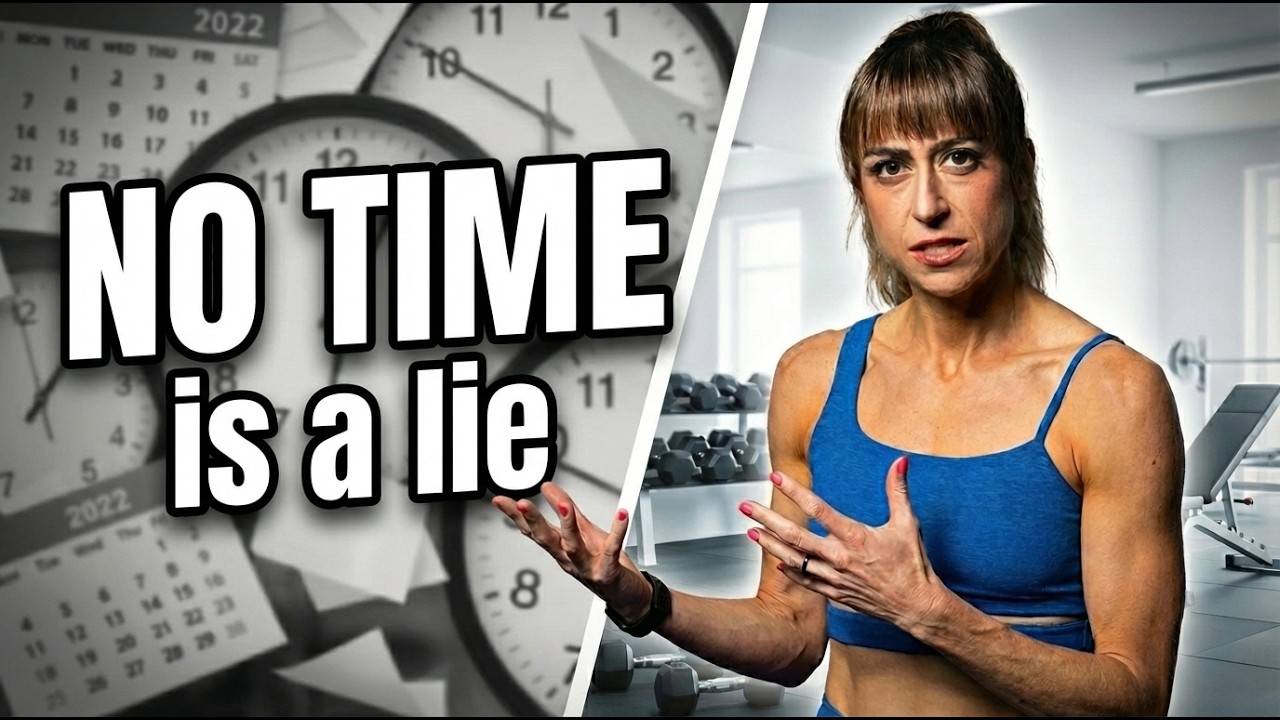“I just can’t eat more protein!”
“It’s impossible to hit my recommended protein intake!”
If you’re starting to adjust your diet to lose fat and build muscle, often your first focus should be on increasing your protein intake.
But it’s a hard thing to do.
It can feel impossible to get more protein and be a struggle because we are used to eating the portions we’ve ALWAYS eaten.
We’ve created meals the same way probably for a long time.
So we default into doing the same things.
And usually those meals are lower in protein than we now need!
That’s why I wanted to share 7 tips to help you boost your protein intake so you can lose fat and gain muscle at the same time!

The first and most important piece of advice I always give to any client starting out is…
Tip #1: Don’t freak. Tweak.
It can feel like we have to completely overhaul our diet when we’re starting out.
Like it is impossible to add another 20 grams to the day.
But often little adjustments to what we’re currently doing really pays off.
So before you start searching for supplements or some crazy meal plan or cut out all of the foods you love, go back to a previous day you’ve logged and see where you can make little adjustments.
And if you haven’t yet logged, logged a day you may do or what you usually eat and then TWEAK IT!
Is there a meal without protein you could add protein to?
Your normal snack of crackers could you swap in jerky instead for that salty treat?
Or is there a meal with protein where you could bump the serving by an ounce?
Adding ounces to our current protein sources can add up and not require us to really change what we’re doing!
Even look for swaps to meals you love that could bump protein, like using lentils over rice in dishes.
Or greek yogurt over sour cream in a dip.
Consider even different cuts of the same type of protein to adjust your macros, swapping in chicken breast for chicken thigh.
But the more you can just make small adjustments, the easier those changes will be.
Don’t first jump to completely changing up the meals you love to eat.
Think small swaps and adjustments.
Tip #2: Use those plant-based sources.
I’m a meat eater personally but I also believe in getting the amino acids you need from a diversity of sources.
This diversity also improves our micronutrient intake.
And not only do I love my plant-based clients, but I also know that some of us don’t just want to be chowing down on a bazillion ounces of chicken or whatever at every meal.
So consider ways you can bump your protein intake through non-animal sources.
Consider adding tofu or tempeh or seitan into any dish even alongside your animal product.
Sprinkle hemp hearts on top of your salads.
Add chia seeds to your smoothies.
Try out buckwheat noodles in your pasta dish.
Pack in more broccoli and peas to your stir fry.
But realize the value of a diversity of vegetables and plant-based sources that can help you make meals tasty while boosting your protein intake!
Tip #3: Swap protein for creamer.
Supplements should always be supplemental.
But they can also be a quick and easy way to help us stay consistent, create a sustainable lifestyle and build meals we enjoy, especially when on the go.
One way I like to use protein powders is even as a replacement for coffee creamer.
Coffee creamers can pack a calorie punch.
And by swapping in protein powder for your creamer, not only can you boost your protein intake easily, you can keep in that delicious morning drink you enjoy.
Plus, you aren’t feeling like you’re just having to power through more protein at another meal.
I love adding in protein powder with coffee as a pre-workout snack.
Get in those amino acids your body will need to repair and even a little caffeine boost to power your workout!
Just be careful if you decide to mix hot coffee and protein powder as it can clump. It works better with ice or combining the protein powder first with a cool liquid you then mix in.
Tip #4: Add egg whites.
Ok I’ll know you didn’t watch a second further if you comment, “EAT THE WHOLE EGG.”
I’m not demonizing yolks here. They are delicious and can be beneficial.
Love whole eggs.
BUT if you are adjusting your macros and even trying to cut calories for body recomp while finding a balance, you may benefit from swapping in some egg whites at times for whole eggs.
In your morning omelet, you may use an egg plus egg whites instead of two full eggs to bump protein without adding as much fat or calories.
You may also add in egg whites to other dishes to easily increase your protein intake.
You can bake egg whites into oatmeal or add them to a fried rice.
Egg white muffins can be great on the go and you can easily make a microwave mug variation adding in any veggies or even other proteins you want!
And if you want a fast snack salty snack, a roasted nut mix is a great option.
Bake nuts that have been tossed in frothed egg whites and seasoning for a protein boost!
Tip #5: Hide It!
If you’re thinking, “These are great BUT I don’t want to have to eat another ounce of chicken.
I don’t want to even have to add another ounce of plant-based protein to have to chew!
I’m sick of protein!”
Then boost your protein intake to start by HIDING IT!
Making a soup?
Try using bone broth instead of your usual vegetable or chicken broth.
Bone broth contains on average 10 grams of protein per serving.
This is about 5 times more than chicken broth and 10 times more than vegetable broth.
Those small changes add up!
Making your morning smoothie?
Half your usual milk or liquid and add in some greek yogurt. Or even consider blending in tofu.
This can be a great way to bump protein and make your smoothie delicious and creamy but without making you feel like you’re having to eat more protein!
Even add in chia seeds or flax seeds or greek yogurt to your normal oatmeal to boost protein and add flavor.
But find little things you can hide in meals you already love that don’t feel like you’re just having to force feed yourself bland chicken!
Tip #6: Don’t forget dairy!
If you can’t consume dairy due to an intolerance or health concern, I’d hope it would be obvious this tip isn’t something you’ll personally want to include.
You may instead focus on the other 6 I’ve shared.
But if you don’t have any issues with dairy and even enjoy it, including things like greek yogurt, cottage cheese and even other cheeses can be a delicious way to bump protein, both in your savory meals and even your desserts!
Greek yogurt can easily be frozen with fruit or chocolate into a bark for a great dessert. Or even made into a parfait.
Cottage cheese can be made into a dip or even added to enchilada bakes or pasta dishes to make them cheesier.
Milk can be added to shakes and smoothies even to bump your protein as well.
So if you enjoy dairy, it can be a great way to diversify how you get in your protein daily!
Actually even parmesan cheese, or what I call protein salt can be a great flavor add and a few extra grams of protein to help you out!
Which brings me to my final protein boosting tip….
Tip #7: Count the grams.
Every gram counts and can slowly chip away at the increase we need.
So often we try to force big changes over looking for the little things that can add up but make the adjustments not feel as overwhelming.
But that’s why reviewing previous food logs and even taking time to learn about the foods we consume is so key.
Because adding something even as simple as parmesan cheese to a dish can not only make the meal more enjoyable and flavorful but also add a protein boost.
While only 2 grams in 2 tsp, that serving of cheese adds a TON of flavor to a dish. And meals we enjoy, we’re going to eat again.
That could also help us slowly increase our protein in a sustainable way.
At 3 grams per tablespoon, nutritional yeast is another great way to add flavor and seasoning while increasing your protein.
It can be sprinkled on your salad, mixed into cottage cheese as a dip or even added to a trail mix or popcorn for extra flavor!
And if you’re plant-based it is a great bonus protein source you could even season your tofu with, adding 3 more grams of protein without having to increase your tofu portion even!
But don’t ignore those little changes that add up!
It is easy to get overwhelmed when we feel like we have to make massive changes to reach our goals.
But don’t freak out! Focus first on those tweaks and then start implementing a few of these tips based on what feels most sustainable to you and your lifestyle.
Small changes meeting ourselves where we are at add up!
And for a great Protein Power Guide, CLICK HERE for a packet with cheat sheets and even a few bonus recipes!



THANKS!!!
🙂 Glad it helped!
I am slowly increasing protein and am confused with beans/legumes.
Tho great for protein, beans/legumes increase carb intake as well?
Is the protein amount the tradeoff from a higher gram of carbs?
Thanks Cori!
Team 1%.
Hi Bethany! Sorry my reply didn’t post before! I told Jamie so we could get you some resources to help! But yes, many plant-based protein sources do have more carbs. Just like some animal sources have more or less fat to them based on the cut!
Protein salt?
Yes that is my joking name for Parmesan cheese as it is very few calories and actually high in protein while adding a “salty” taste to food.
Full fat dairy or no fat fat dairy?
Honestly EITHER can work based on your macros and even dietary preference 🙂
Thanks for useful tips
Glad they help!
Thanks for the information
Thank-you. 🌷👍🏻
THANK YOU! I’m still trying to get a grip on the whole “counting macros” thing. All the math scares me away…😂
Thank you for the tips- these are manageable for sure. How about those protein drinks like Ensure- can those be added to protein shakes/coffee? Is adding protein on top of protein a waste?
I get it. It’s why I avoided it personally for the longest time. But honestly, using a fitness tracker takes away a lot of the work as it just does the match for you. I can tell you though the best way to start is just to track what you’re doing currently. Then you pick ONE small change to a portion and you’ll be surprised by how much that adds up alone!
So you can do like two scoops of whey protein or such so ensure plus whey in a coffee wouldn’t be bad. BUT that’s also adding more processed on processed over focusing on ways we can adjust with whole natural foods. So I’m definitely not opposed to it if it helps to start or is part of your balance but the more you can use the adjustments with whole natural foods too, the better!
Thank you very helpful
So glad it helps!
How much protein should one have every day?
Our protein needs vary based on goals, dieting history, activity level, age…so many factors. The best place to start is by tracking what you’re currently doing. Here’s a beginner’s guide to macros too to help – https://redefiningstrength.com/the-beginners-guide-to-macros?sl=blogcomment
Thanks for your suggestions, they are really valuable & simpke
So glad they help Trish!
I need a list of protein foods. What to eat for breakfast, lunch and dinner. I don’t want any meal plans .
You may want to consider my metabolic shred if you’re looking for help to adjust your diet without meal plans – https://redefiningstrength.com/the-metabolic-shred?sl=blog
But I’d also recommend you use these tips to adjust the protein you’re currently eating as you can break up your protein increase over the day however you’d like. You don’t have to eat specific things for each meal 🙂
This is amazing 🤩!!! And thank you so much for sharing this wonderful information!!!
So glad it helps Janet!
Love the coffee ☕️ tip !
Glad it helped! Side note too I’ve found this new coffee protein Chike. I’m legit obsessed as I now don’t have to make coffee AND get a protein. It’s BOTH already combined and easier to make hot or cold. Just sharing since you mentioned this tip – https://get.aspr.app/SHtVt
Thanks so much, heard about you from a couple of friends
Glad the video helps Dianne! Welcome to RS!
Just recently started Metabolic Shred and I trying to up my protein and carbs to get to my percentages. I’m having a hard time, when I add more protein I’ll see the percentage doesn’t change or hardly at all and then my carbs may go down. I can’t seem to add more of anything without going over in calories too. The fat percentage is always way over. I’m using My Fitness Pal, is there a better one out there? Have you considered starting with the minimalist macros instead?
Great tips 👌
So I’m not sure how you’re not seeing the percent change if you’re adding more protein? Are you looking at the grams to see your daily totals based on your ratio and shoot for those? I’d log a day ahead of time that you normally would do and check out the cheatsheets to see lower fat protein options and such. And even just tweak portions of fats. There is a cheatsheet that breaks down foods for each macro in there 🙂 It does take time though. You’re used to eating portions in the way you’ve always eaten them so you have to learn to adjust to new portion sizes and meals.
Glad they help!